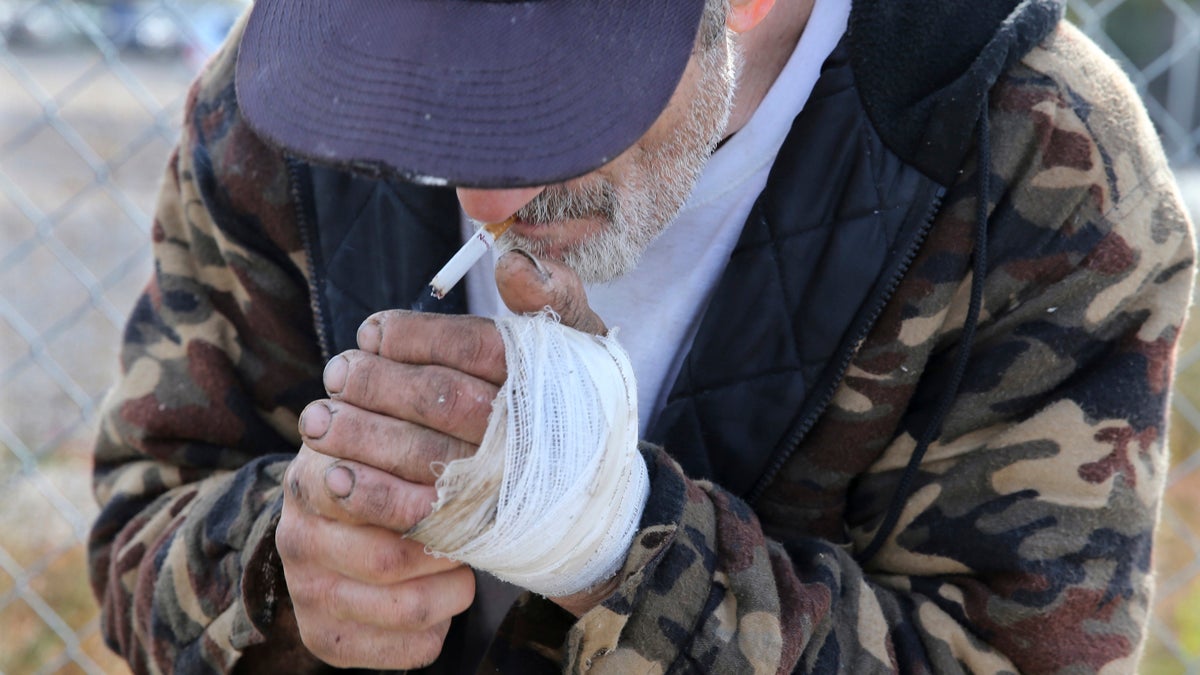Mortality rate increases for middle-aged white Americans, Princeton study finds

In this Thursday, Oct. 29, 2015 photograph, Jim 'Woods' Ellis lights the stub of a cigarette as he stands in an industrial area of Camden, N.J. Woods describes using the drug, naloxone, often known by the brand name Nacran, to reverse a heroin overdose. (Mel Evans/AP Photo)
For decades, death rates have been dropping for middle-aged Americans. But a new Princeton study has revealed that the good news doesn’t apply to everyone.
Over the last 15 years, while nearly every other racial or ethnic group has made gains, whites ages 45 to 54 have not, with the most pronounced shift in those with a high school education or less. Between 1999 and 2013, the mortality rate of uneducated middle-aged whites increased by 22 percent.
Nobel laureate Angus Deaton identified the trend with fellow Princeton economist Anne Case, who is also his wife.
“We knew that suicides were going up,” he said. “But that wasn’t enough. And so we started looking for the other things. I remember, it was sort of like peeling an onion.”
The pair checked for increases in the number of deaths due to cardiovascular disease, cancer, and traffic accidents, among other potential causes. Even obesity, which has been on the rise, has not substantially pushed up diabetes deaths for the age group. But drug and alcohol poisoning and chronic liver diseases have taken a toll. With suicide, those factors account for nearly the entire climb in the death rate.
Contrary to the perception that suicide is primarily a problem for men, Deaton said that the mortality hikes were seen about equally in both genders.
The study, which was published this week in the journal PNAS, can’t pinpoint the reason behind the surge in mortality, but the timing fits for the rise of prescription painkillers in the 1990s to be a part of it. Implicated, too, is a new economy that doesn’t offer much for those without a college degree.
“A lot of people are experiencing a race to the bottom,” said Adam Brooks, a clinical research scientist at the Treatment Research Institute in Philadelphia. “What comes along with that is significant stress, significant impact on your health, and then risk to develop problems that are related to coping: alcohol use, addiction, and then suicide.”
Carolina Hausmann-Stabile, a suicide researcher at Temple University, said the findings raise important questions about how society can begin to address these problems.
“This is a critical discussion that is missing in general in the country,” she said. “We need to focus on understanding what happens when social conditions change that impact the quality of the health, but also impact well-being among people.”
The researchers also looked at survey responses from middle-aged whites about their health. Mirroring many of the trends in causes of death, respondents in the group reported worsening physical and mental health, and increased pain and disability over time.
Deaton likened the mortality increase to the AIDS epidemic, noting that loss of life to suicide and substance abuse among this group was on the same scale as those lost to HIV, yet has garnered very little attention.
“There’s a lot of shame, and people think they’re alone in this,” he said. “I think one of the big things of this paper is just to explain to people they’re not alone. There’s a huge amount of this going on.”
WHYY is your source for fact-based, in-depth journalism and information. As a nonprofit organization, we rely on financial support from readers like you. Please give today.

